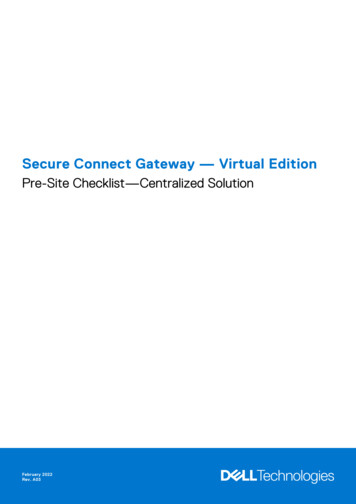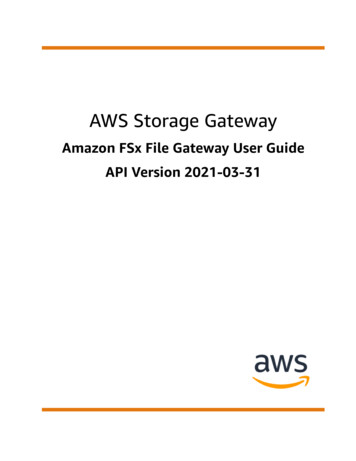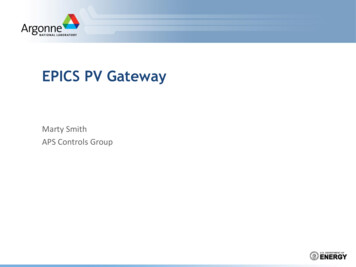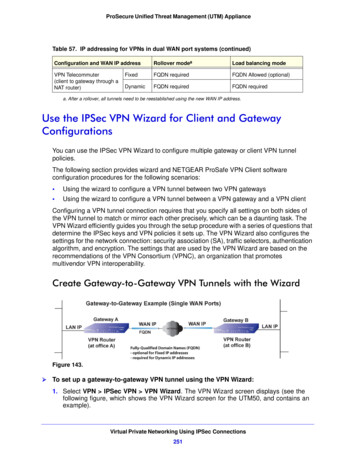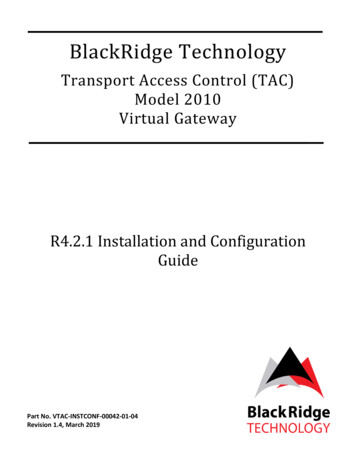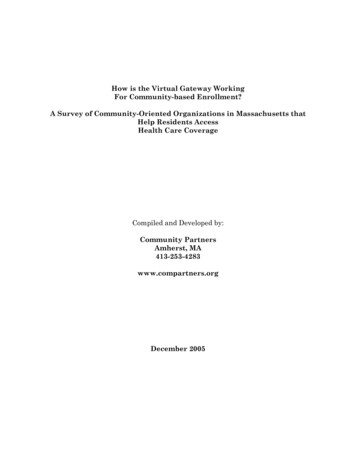
Transcription
How is the Virtual Gateway WorkingFor Community-based Enrollment?A Survey of Community-Oriented Organizations in Massachusetts thatHelp Residents AccessHealth Care CoverageCompiled and Developed by:Community PartnersAmherst, MA413-253-4283www.compartners.orgDecember 2005
2TABLE OF CONTENTSWhat Is Community Partners?p. 3Why Ask People on the Frontlines?p. 3Acknowledgementsp. 3Executive Summaryp. 4Methodologyp. 5Respondent Informationp. 6Part I: Themes Within the FindingsThe Virtual Gateway as an Enrollment ToolCoordination and Integration of Systemsp. 7p. 7p. 9Part II. Selected Responses To Survey Questionsp. 12Overall Experience Of Respondentsp. 12Appendix A: Towns Represented by Organizationsthat Participated in this Surveyp. 20Appendix B: Glossary Of Pertinent Termsp. 21**Expertise provided by dedicated staff members in community organizations throughout Massachusetts**Compiled and Developed and by Community Partners, December 2005www.compartners.org
3WHAT IS COMMUNITY PARTNERS?We are a small non-profit organization based in Amherst, Massachusetts. We workin support of and in collaboration with community health access programsthroughout the Commonwealth. We serve as an intermediary and convener, helpingto share information that can enhance implementation of health care programs andbetter inform effective policy.Community Partners believes that a strong and just society takes responsibility forensuring that all its members have an equal chance for a healthy life. As a result,we work as an intermediary to bring together frontline workers, advocates, andgovernment to ensure access to health care that is equitable, responsive,accountable and grounded in the practical realities of people’s lives.Community Partners staff can be reached at 413-253-4283. Our email isaccess@compartners.org and our website is www.compartners.orgWHY ASK PEOPLE ON THE FRONT LINES?There are many people across the Commonwealth who work to advance access tohealth care every day. They work in a variety of organizations – hospitals,community health centers, community organizations – directly helpingMassachusetts residents get care through MassHealth, the Children’s MedicalSecurity Plan, Free Care (Uncompensated Care Pool) – all accessible via theCommonwealth’s new Virtual Gateway. These frontline health access workersserve as crucial guides to health care coverage in the Commonwealth and areexperts in the realities faced by people with low- and moderate-incomes seekingpublicly-funded health care. We felt it would be constructive to ask these peoplewhat they think about the Virtual Gateway enrollment process.ACKNOWLEDGEMENTSWe wish to thank the many frontline health access experts who provide enrollmentassistance for low- and moderate-income residents in Massachusetts in need ofhealth coverage. This report is a result of their practical experience and knowledgefrom doing this work to help the under- and uninsured in our society, day in andday out. Community Partners wishes to thank these many individuals for theircommitment, their collective and individual wisdom, and most immediately, fortheir willingness to share what they know to better inform policy and programimplementation.**Expertise provided by dedicated staff members in community organizations throughout Massachusetts**Compiled and Developed and by Community Partners, December 2005www.compartners.org
4EXECUTIVE SUMMARYMethodology: Community Partners sent out an email to 973 people involved in ourstatewide network inviting them to participate in an online survey about the effects ofthe Commonwealth’s new Virtual Gateway system on enrollment into publicly-fundedhealth care, predominantly MassHealth and Free Care. The results are not intended tobe scientific. The purpose is to gather the important and unique perspectives fromprofessionals who work the closest with low- and moderate-income residents ofMassachusetts who are now being enrolled via the Virtual Gateway.Respondents: A total of 61 individuals from across the Commonwealth responded; 52of these are frontline workers directly assisting uninsured residents with theenrollment process. These individuals represent 40 separate organizations including:38% hospitals; 31% community health centers; 21% community organizations; and 10%local/other health care providers. These organizations are located in 27 towns andcities.Themes Within the Findings:The Virtual Gateway as an Enrollment ToolThe Virtual Gateway is a powerful and sophisticated tool but like all tools it requiresadjustments and improvements as it evolves and becomes fully integrated into theworkflow of frontline workers and the Commonwealth. The Virtual Gateway is making frontline workers’ jobs easier. The Virtual Gateway is significantly reducing the time necessary for an eligibilitydetermination. Applying through the Virtual Gateway is a positive change for most clients. Structural limitations of the Virtual Gateway make some aspects morecumbersome. The Virtual Gateway’s specificity means some clients do not fit. Technical support is strong.Coordination and Integration of SystemsSince the Virtual Gateway is part of a larger, complex system of eligibilitydetermination and coverage benefits, the introduction of this new tool has changedsystems, procedures and workflow for frontline workers who provide enrollmentassistance. The introduction of the Virtual Gateway means review and education about howvarious systems at MassHealth relate. New tool highlights needed adjustments in processing of applications. The integration of Free Care (the Uncompensated Care Pool) into MassHealth hasleft some clients unaware of their eligibility. Heightened role of frontline workers as “gatekeeper” increases caseload.**Expertise provided by dedicated staff members in community organizations throughout Massachusetts**Compiled and Developed and by Community Partners, December 2005www.compartners.org
5METHODOLOGYOn November 10, 2005, Community Partners sent out an email to 973 peopleinvolved in our statewide network. The email invited individuals to participate inan online survey about the effects of the Commonwealth’s new Virtual Gatewaysystem on enrollment into publicly-funded health care, predominantly MassHealthand Free Care. On November 15, another round of similar emails was sent out toremind them of the survey deadline.A total of 61 respondents (6.2% response rate) participated in the survey. 52 ofthese respondents work directly assisting uninsured residents with the enrollmentprocess. Data from these 52 individuals was compiled between November 18 andDecember 7, 2005 by staff at Community Partners, Inc. using standard spreadsheetsoftware. The results have been documented in this report.The results are not intended to be scientific. The purpose of the process has been,rather, to gather the important and unique perspectives and expertise fromprofessionals who work the closest with low- and moderate-income residents ofMassachusetts who are now being enrolled via the Virtual Gateway.**Expertise provided by dedicated staff members in community organizations throughout Massachusetts**Compiled and Developed and by Community Partners, December 2005www.compartners.org
6RESPONDENT INFORMATIONA total of 61 individuals from across the Commonwealth responded. As noted above,52 of these respondents directly assist uninsured residents with the enrollmentprocess.These individuals represent 40 separate organizations involved with providing orpromoting access to health care for low- and moderate-income residents ofMassachusetts. These organizations include community hospitals, community health centers,anti-poverty organizations, ethnic group support organizations, legalassistance agencies and visiting nurse associations, among others. They are:o 38% hospitalso 31% community health centerso 21 community organizationso 10% local/other health care providers These organizations are located in 27 towns and cities of the Commonwealthincluding Boston, Worcester, Springfield, Pittsfield, Truro, Tisbury, Orange,Northampton, Lawrence, Lynn, Huntington and Fitchburg.Virtual Gateway Usage by RespondentsAre you currently using the Virtual Gateway to enroll your clients?Yes- 50 (96%)No- 2 (4%)What percentage of MBRs are you now doing via the Virtual Gateway?26517675%100%0-25% 50%305406%0%10%83%Training of Respondents on Virtual GatewayWho primarily trained you to use the Virtual Gateway?FiguredOrganizational it outOtherstaff who were by(pleaseyourself specify)MassHealth trained3675%1021%00%24%**Expertise provided by dedicated staff members in community organizations throughout Massachusetts**Compiled and Developed and by Community Partners, December 2005www.compartners.org
7PART I: THEMES WITHIN THE FINDINGS1. The Virtual Gateway as an Enrollment ToolAfter analyzing the responses from the survey, we at Community Partners werereminded that the Virtual Gateway is simply a tool for enhancing enrollment. It is apowerful and sophisticated tool but like all tools it requires adjustments andimprovements as it evolves and becomes fully integrated into the workflow offrontline workers and the Commonwealth. Given the high profile the VirtualGateway has attained during implementation and its significant impact on priorprocedures, it is worth highlighting this relatively obvious point when evaluating itseffectiveness and looking toward future planning.¾ The Virtual Gateway is making frontline workers’ jobs easier.Overall, frontline users of the Virtual Gateway are happy with the tool andbelieve the Virtual Gateway has made a significant difference in their ability todo their jobs and assist their clients/patients. 90% stated that the VirtualGateway made their jobs much or somewhat easier. Similarly, 98% ofrespondents stated that their experience using the Virtual Gateway was eithervery or somewhat smooth.“People are enrolled faster, enabling the case to be complete in less time”“Quick, easy to complete, more comprehensive than doing a paper applicationfor both Free Care and for MassHealth. It is also easier to verify the date thatthe application was received.”¾ The Virtual Gateway is significantly reducing the time necessary for aneligibility determination.A primary concern of frontline workers is that their clients get the care theyneed when they need it. Many respondents mentioned that clients find out theyare eligible much more quickly than under the old all-paper system. Gettingcovered sooner means that they are able to get treatment sooner, and for somethis can be a life-saving difference. The organizations providing treatment mayget reimbursed more quickly as well.“It has made it much easier to enroll patients quickly and efficiently, and italso enables me to get them coverage for their critical treatments within aweek.”“Virtual Gateway is much faster than the old application. I'm able to enterthe info into the system in far less time than it takes a patient to fill out theform. The results are much timelier also.”**Expertise provided by dedicated staff members in community organizations throughout Massachusetts**Compiled and Developed and by Community Partners, December 2005www.compartners.org
8¾ Applying through the Virtual Gateway is a positive change for most clients.Frontline workers report that many applicants have had difficulty filling outpaper applications on their own, which can result in erroneous denials ofeligibility. Respondents report that their clients are more relaxed answeringoral questions – and that they are returning required verifications to their accessworker more quickly and more frequently. Earlier concerns that clients mightbe put off by the interposition of a computer between themselves and theoutreach worker were not mentioned.“Clients appreciate that someone else fills in the information, especiallysomeone they feel knows what they are doing.”“Patients seem to bring in documentation sooner.”¾ Structural limitations of the Virtual Gateway make some aspects morecumbersome.At this time MassHealth applications on the Virtual Gateway require anelectronic submission, faxed documents and signature pages sent by regularmail. Many respondents found keeping track of three separate modes ofcommunication quite burdensome. The time and costs involved in follow-uppaperwork and printing have also increased for some programs.“Having to fax the income and then send [mail] the signature page andPermission to Share Information (PSI) form makes things more tedious ordifficult.”“Why not accept faxed or electronic signatures? Medicare is acceptingelectronic signatures for Part D plans. Our costs for mailing and printinghave gone way up, never mind the cost to acquire and maintain the DSL andcomputer equipment.”¾ The Virtual Gateway’s specificity means some clients do not fit.The use of a common online application, while it streamlines the process greatly,can create difficulties for some clients because they are limited to certainanswers that might not apply in their situation.“It needs to have a box for seasonal employment option.”¾ Technical Support is strong.Respondents felt well-supported by MassHealth staff in initial Virtual Gatewayset-up, learning how to use it, and getting effective help when they needed it.The vast majority of respondents expressed appreciation for the Virtual Gatewayhelp desk citing that it is consistently helpful and responsive.**Expertise provided by dedicated staff members in community organizations throughout Massachusetts**Compiled and Developed and by Community Partners, December 2005www.compartners.org
9“Virtual Gateway Help Desk staff are wonderful!” “They have been helpful,friendly, responsive and patient.”**Expertise provided by dedicated staff members in community organizations throughout Massachusetts**Compiled and Developed and by Community Partners, December 2005www.compartners.org
102. Coordination and Integration of SystemsBecause the Virtual Gateway is part of a larger, complex system of eligibilitydetermination and coverage benefits, the introduction of this new tool has changedsystems, procedures and workflow for frontline workers who provide enrollmentassistance. Reponses from the survey indicate two things: 1) that frontline workerswould benefit from a better understanding of the systems and how they work giventhe introduction of the Virtual Gateway; and 2) while the Virtual Gateway tool isworking well, further integration into the larger systems is needed.¾ The introduction of the Virtual Gateway means review and education of howvarious systems at MassHealth relate.Over the years, frontline staff developed a complex understanding of theprocesses at work when a MassHealth application is submitted. Theintroduction of the Virtual Gateway resulted in a changed landscape. Someprocedures and relationships stayed the same; others changed. Comments madeby responders to the survey indicate a need to better understand these systemsand procedures now that the Virtual Gateway is in place, increasing theireffectiveness when interacting with MassHealth on behalf of an applicant.Specifically, they need to understand what changed, what did not, and how bestto engage the official MassHealth systems for different issues.“We would send verifications to both the MEC and the Virtual Gateway, andwe'd still continue to get notices about missing verifications”“Even though income verifications get faxed to CPU the same day theapplication is entered in the Virtual Gateway, 99.9% of the applications endup being referred to the MEC.”¾ New tool highlights needed adjustments in processing of applications.Respondents offered observations about systems and procedures that can beimproved upon. These include issues such as needing to fax and maildocumentation after submitting the application online or being able to easilycheck the online MassHealth billing system (REVS) to get an up-to-date statusfor an applicant. Understandably, these larger systems issues are complex froma technical, policy and legal perspective, but we offer the comments fromcommunity-oriented users of the Virtual Gateway; people who daily need to workwith this interface to the MassHealth system.“The application process goes fairly smoothly and it is great to see that theapplication has been received. Sorting and faxing and mailing after theapplication is submitted are a pain and often we end up re-faxing things. Canthe process be stream-lined? Why not accept faxed or electronic signatures?”**Expertise provided by dedicated staff members in community organizations throughout Massachusetts**Compiled and Developed and by Community Partners, December 2005www.compartners.org
11¾ The integration of Free Care (the Uncompensated Care Pool) into MassHealthhas left some clients unaware of their eligibility.Legal notices of eligibility are a constant source of confusion and discussionbetween applicants, frontline workers, MassHealth staff and advocates. With thecombined application for MassHealth and Free Care now practically in place viathe Virtual Gateway, applicants are finding it confusing to sort out for whichprograms they are approved and/or denied.“Clients who are ineligible for MassHealth and are applying for Free Carethrough the Virtual Gateway often misunderstand the denial response fromMassHealth that is necessary for eligibility for Free Care, and they mistakenlyassume they are eligible for nothing.”“They read that they are denied MassHealth but fail to read on to see that theydo qualify for 'uncompensated care.' Most people have no clue what thatmeans. I think the letter should be revised so that people understand what itmeans.”¾ Heightened role of frontline workers as “gatekeeper” increases caseload.Since only professional staff trained by Virtual Gateway personnel can use theonline application process, and because this enrollment procedure is increasinglyrecognized as the preferred method for applying for coverage, clientsincreasingly need to work one-on-one with a frontline worker to enroll forMassHealth or Free Care. In the past, some clients would have preferred andbeen able to complete an application on their own. This is increasing thecaseload for these frontline workers whose organizations do not have theincreased capacity.“I seem to deal with people much more on a one-to-one basis.”“It is also somewhat more difficult to enroll people, as they must come to us toenroll online [instead of doing it themselves]. Many want paper applications,but we try to discourage this because of the tremendous backlog in the mail atthe MEC.”¾ Possible creation of a two-tiered enrollment system.In the early months of broad-based implementation of the Virtual Gateway,there was an understandable backlog of paper applications, as the MassHealthsystem adapted to new systems and increased online demand. The result was atwo-tiered system—the Virtual Gateway, which could process applicationswithin hours or days, and the traditional paper application system that tookweeks. While this disparity did not exist in every case, and we expect it willlessen with time, it is a concern. Situations where paper applications are**Expertise provided by dedicated staff members in community organizations throughout Massachusetts**Compiled and Developed and by Community Partners, December 2005www.compartners.org
12necessary will persist. However, individuals who are unable to work directlywith a professional providing enrollment assistance, for reasons includingconfidentiality concerns, lack of childcare or transportation, or insufficientlanguage capacity at a site, may face longer waits for eligibility determinationand subsequent delays in coverage and care.“School referrals that ask to have the application mailed to them. This isusually single parents who would find it hard to see me in person between 9and 5. If I go to a high school to help a student, I must use paper applicationsso that the students can bring the applications home for the parents to signand fill in any missing information. Parents do not usually want theirteenagers to see their pay stubs.”[I use paper applications in cases of] “domestic violence or when strictconfidentiality is needed due to dangerousness.”**Expertise provided by dedicated staff members in community organizations throughout Massachusetts**Compiled and Developed and by Community Partners, December 2005www.compartners.org
13PART II. SELECTED RESPONSES TO SURVEY QUESTIONSA total of 8 narrative questions were asked of participants about their directexperience with the Virtual Gateway. A selection of these responses, indicative ofthe breadth of answers, is included in the following pages.OVERALL EXPERIENCE OF RESPONDENTSUsing the Virtual Gateway has made my job:MuchSomewhatNoMore difficultVery difficulteasiereasierchange62%28%6%2%2%2913311When you enroll someone via the Virtual Gateway, how is your onlineexperience?somewhatI have frequentvery smooth, smooth,trouble, it takesgoes quickly, occasionallonger than I think serious trouble - I don't feelno problemsglitchesit shouldlike I can rely on it50%48%2%0%232210**Expertise provided by dedicated staff members in community organizations throughout Massachusetts**Compiled and Developed and by Community Partners, December 2005www.compartners.org
14QUESTION: In what ways has the Virtual Gateway made your job easier or moredifficult?Easier: One application for many different programs is fantastic. Turn-around time for anapplication has been consistently about 10 days. I used to average three differentapplications for one client. I love looking in the REVS to see where people stand withenrollment in MassHealth and Uncompensated Care Pool. I no longer have to proveMassachusetts residency. This used to hold up many applications. People do comeback with the needed documentation for income much more frequently than they didwith paper applications. I discourage paper applications. Many clients did not mailthem or do follow-ups when necessary. Clients appreciate that someone else fills in theinformation, especially someone that they feel knows what they are doing. I think thatthe Virtual Gateway is great. Patients seem to bring in documentation sooner. I seem to deal with people much moreon a one-to-one basis. Virtual Gateway is much faster than the old application. I'm able to enter the info intothe system in far less time than it takes a patient to fill out the form. The results aremuch timelier also. Quicker turn-around time in determination. Being able to check REVS so quickly has been wonderful. Can confirm that an application has been received almost immediately. Easier accessto the status of an application. While it is not 'easier' to enter the apps ourselves, it does save the tremendous time wespent calling the MEC's (MassHealth Enrollment Centers) and searching for 'lost apps'. Takes the pressure off the staff about approving status and collecting the requiredinformation. 'The State requires that we collect this information'. Patients haveresponded well and are much more compliant. Quick, easy to complete, more comprehensive than doing a paper application for bothFree Care and for MassHealth. It is also easier to verify the date that the applicationwas received by the MEC. People are enrolled faster, enabling the case to be complete in less time. It is faster. Information is saved and can be reviewed at any time. More expedient response to applications, which reduces amount of follow-up workrequired. Decreased the amount of paperwork and confusion, thus probability of errorin our office. It has made it much easier to enroll patients quickly and efficiently, and it also enablesme to get them coverage for their critical treatments within a week. When we call the CPU, having an application number helps us track applicationstatus.**Expertise provided by dedicated staff members in community organizations throughout Massachusetts**Compiled and Developed and by Community Partners, December 2005www.compartners.org
15More difficult: No change from the old Free Care application process in the amount of time needed tointerview patient using bedside tool, collecting documentation and then entering intoVirtual Gateway. This app seems quicker, but the paperwork following and the copying and faxing canbecome overwhelming when we are busy. We have had to change printers due to theexcessive amount of printing now done. We chose a printer using less expensive ink,and along with the excessive amount of paper, processing costs have increased. It is still difficult because you are limited to certain answers on the Virtual Gatewaythat may not apply in a particular person's situation. Having to fax the income and then send the signature page & PSI (Permission to ShareInformation form) makes things more tedious or difficult. It is also somewhat more difficult to enroll people, as they must come to us to enrollonline [instead of doing it themselves]. Many want paper applications, but we try todiscourage this because of the tremendous backlog in the mail at the MEC. Easier to enroll, but information not always received correctly, spend more time withfollow-ups. Using the Gateway to process applications has made things quicker for eligibility, butmy problems come in dealing with the MassHealth regulations for Free Care clients. Ifind myself spending more time on the phone with the MEC; it seems that more andmore people are coming up ineligible for Free Care before their year-end is up. Morereviews are being sent out before the one year is up, which means more job updateforms and more returned mail. Clients are reading letters from MassHealth that state'your MassHealth benefits will be stopped if this form not returned'. Clients read thatand say “I don't have MassHealth, so I don't need to return it.” Thus more people aregetting terminated, and more calls to the MEC result. The difficulty has been tracking these applications on a weekly basis so we can get ourreimbursement and keep our database up to date.**Expertise provided by dedicated staff members in community organizations throughout Massachusetts**Compiled and Developed and by Community Partners, December 2005www.compartners.org
16QUESTION: What has been the most significant change, if any, for your clientswhen you enroll them via the Virtual Gateway instead of through paperapplications? The clients get a decision much quicker than if they had done the paper MBRapplication.Clients seem to appreciate not having to fill out the paper MBR'S.No more same-day approvals for Free Care, although the processing time for aMassHealth determination is much faster.For those with no income and/or other verifications needed, there’s a very quickturnaround on eligibility when only CPU is involved in the process.Everything! Transmission, record number, showing date of application (which isimportant with respect to eligibility date for coverage), tracking for duplicationenrollment. Everything!!Clients are more relaxed having to answer oral questions than to labor over the writtenones.Instant submission makes enrollment faster and the number of 'lost' applications hasdecreased substantially.The reduced need for proof of residency for Free Care applications.Being able to refer clients to other public agency that clients may qualify for.**Expertise provided by dedicated staff members in community organizations throughout Massachusetts**Compiled and Developed and by Community Partners, December 2005www.compartners.org
17QUESTION: In what situations do you still use paper applications? When people cannot come in to our office for a face-to-face meeting.Individuals who do not want to give absent parent information--but rarely.Katrina Evacuees.Eligibility Reviews.Applicants over 65 years of age.Bedside situations where applicant is homebound or hospitalized.Only if a patient or member requests for an application to be sent. I explain to themthat it is a lot faster if they were to come in, or to contact another hospital orCommunity Health Center that has the VG.Only if our laptop is not working at a particular site.Medical Hardship.Confidential patients.Disability applications which we need to do for every patient 64 and under. 65 and overfor nursing home transition.Rare situations: non-patient inquiries and/or family member doing app for anotherfamily member of another family, etc.I do not use paper MBRs. I do use the Bedside Tool 100%. With requests to mail apps,I send the Bedside Tool so I can get the PSI and Signature Page back.Domestic violence or when strict confidentiality is needed due to dangerousness.Patients who come in off the street and ask for an application to mail in themselves.School referrals that ask to have the application mailed to them. This is usually singleparents who would find it hard to see me in person between 9 and 5. If I go to a highschool to help a student, I must use paper applications so that the students can bringthe applications home for the parents to sign and fill in any missing information.Parents do not usually want their teenagers to see their pay stubs.**Expertise provided by dedicated staff members in community organizations throughout Massachusetts**Compiled and Developed and by Community Partners, December 2005www.compartners.org
18QUESTION: What is working particularly well on the Virtual Gateway? Pleaseinclude specific suggestions as to how it might be improvedWorking Well: It is a great tool, even when a correction is needed. Now we'll be doing the over-65population, that's awesome. Keeping the question format the same or similar to paper application reducesmistakes; ability to suspend application is very useful. The over-65 application process is going great, I think mainly because the MECs areprepared for this form of community intake.Specific Improvements I suggest they put all the income questions togethe
¾ The Virtual Gateway is making frontline workers' jobs easier. Overall, frontline users of the Virtual Gateway are happy with the tool and believe the Virtual Gateway has made a significant difference in their ability to do their jobs and assist their clients/patients. 90% stated that the Virtual Gateway made their jobs much or somewhat easier.


